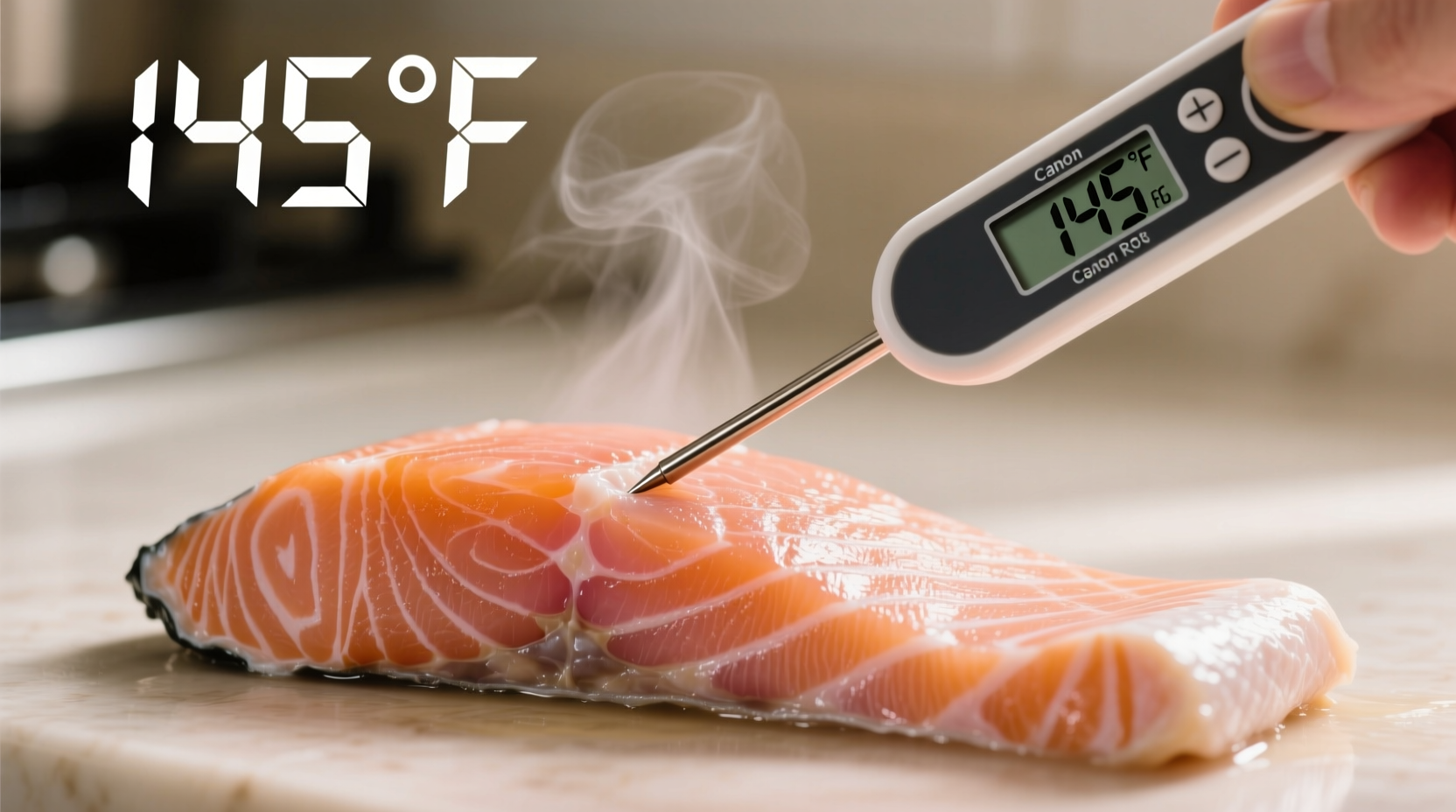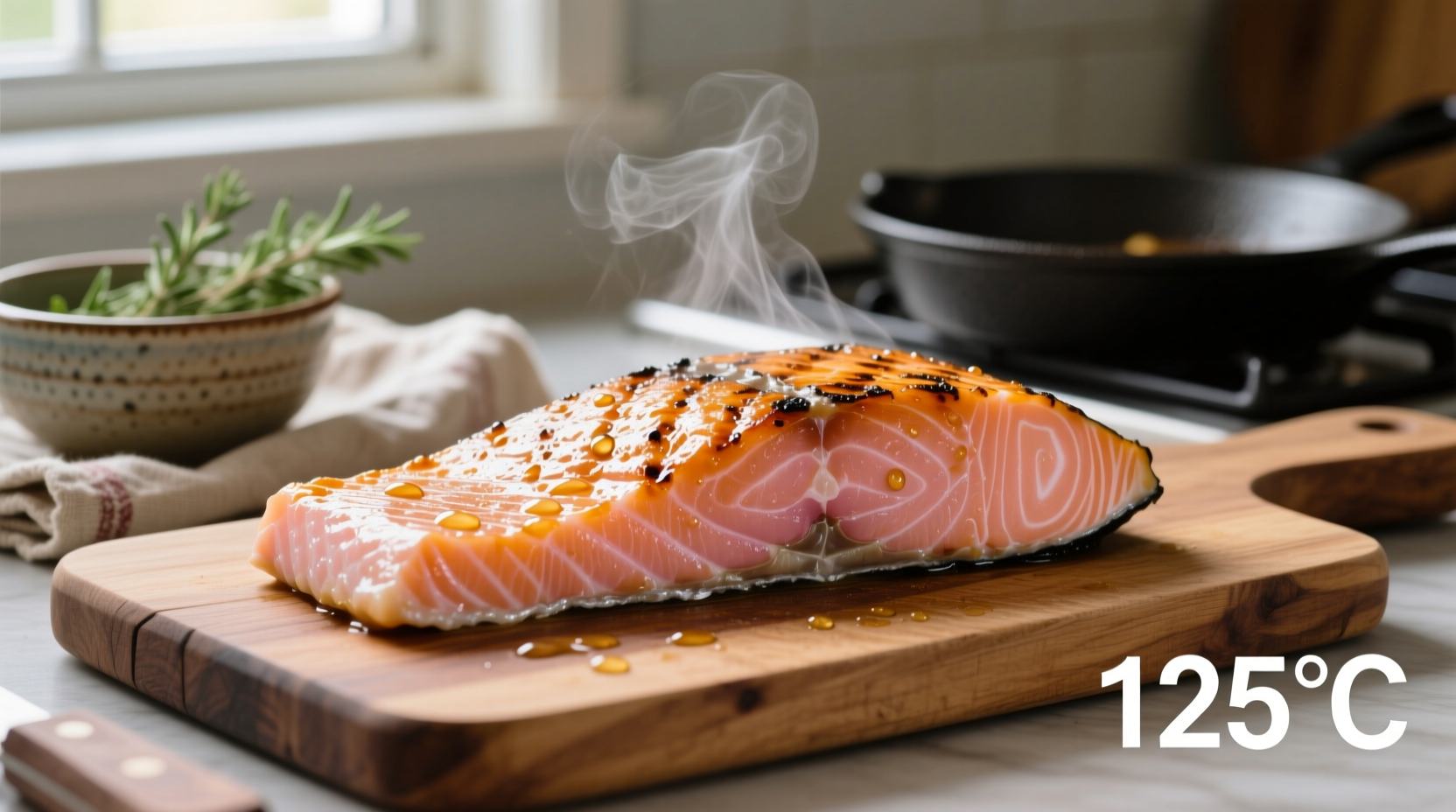The perfect internal temperature for cooking salmon is 125°F (52°C) for medium-rare, which will gently rise to 130-135°F (54-57°C) during resting. For those prioritizing food safety over texture, USDA recommends 145°F (63°C), though this often results in drier fish. This guide reveals why temperature matters more than timing, how to measure accurately, and how to achieve restaurant-quality salmon every time.
Getting salmon temperature right transforms an ordinary meal into a culinary triumph. While many home cooks rely on cooking time or visual cues alone, precise temperature control is the professional chef's secret to perfectly cooked salmon—moist, flavorful, and safe to eat. Let's explore the science-backed approach that guarantees success whether you're pan-searing, baking, or grilling.
The Science Behind Salmon Temperature
Salmon's delicate texture responds dramatically to heat. As the fish cooks, proteins denature and coagulate, squeezing out moisture. Understanding this process explains why temperature precision matters more than cooking duration:
- 120°F (49°C): Salmon begins transitioning from translucent to opaque
- 125°F (52°C): Medium-rare perfection—center remains slightly translucent with buttery texture
- 130°F (54°C): Medium doneness—flaky but still moist throughout
- 135°F (57°C): Medium-well—fully opaque with minimal moisture loss
- 145°F (63°C): USDA's safe minimum—fully cooked but often dry
Unlike steak, salmon continues cooking significantly after removal from heat due to its high fat content and thinner profile. This carryover cooking typically adds 5-10°F (3-5°C), making precise temperature monitoring essential.
Essential Tools for Temperature Accuracy
Using the right thermometer properly makes all the difference. Here's what professional chefs recommend:
| Thermometer Type | Best For | Accuracy Tips |
|---|---|---|
| Instant-read digital | Quick checks during cooking | Insert horizontally into thickest part, avoid bone |
| Leave-in probe | Oven or grill cooking | Place probe in center, set alert 5°F below target |
| Laser infrared | Surface temperature checks | Not reliable for internal temp; use as supplement only |
Avoid common mistakes like checking temperature too frequently (causes moisture loss) or inserting the probe incorrectly. For accurate readings, insert horizontally into the thickest part of the fillet, avoiding the bone which conducts heat differently.

Step-by-Step Temperature Guide for Perfect Salmon
Follow this chef-approved process for flawless results every time:
Preparation Phase
Remove salmon from refrigerator 15-20 minutes before cooking. Cold fish cooks unevenly, making temperature control difficult. Pat dry thoroughly—moisture creates steam that prevents proper searing and accurate temperature readings.
Cooking Phase
Regardless of method (pan-searing, baking, or grilling), monitor temperature beginning when the salmon appears about halfway cooked. For most 1-1.5 inch fillets, this is approximately:
- Pan-searing: After 3-4 minutes per side
- Baking: At the 8-10 minute mark (for 400°F/200°C oven)
- Grilling: When the bottom half appears opaque
Checking Phase
Insert your thermometer horizontally into the thickest part:
- For medium-rare: Remove at 120-125°F (49-52°C)
- For medium: Remove at 125-130°F (52-54°C)
- For medium-well: Remove at 130-135°F (54-57°C)
Remember that carryover cooking will continue raising the temperature after removal from heat.
Resting Phase
Let salmon rest 5-7 minutes tented with foil. During this critical period:
- Temperature rises 5-10°F (3-5°C)
- Proteins relax, redistributing juices
- Texture becomes more uniform throughout
Contextual Considerations for Different Cooking Methods
While the target internal temperature remains consistent, cooking method affects how you achieve it:
| Cooking Method | Temperature Nuances | Special Considerations |
|---|---|---|
| Pan-searing | High heat creates rapid surface temperature rise | Check temp earlier; skin helps insulate bottom |
| Baking | More gradual, even heating | Thermometer can remain in oven; check 2-3 minutes before expected finish |
| Grilling | Variable heat zones affect cooking rate | Move to cooler zone when 5°F from target temp |
| Poaching | Water temp caps at 212°F (100°C) | Remove at 125°F (52°C); carryover minimal |
Troubleshooting Temperature Issues
Even with careful monitoring, challenges arise. Here's how to handle common scenarios:
Undercooked Salmon (Below 120°F/49°C)
If your salmon hasn't reached minimum safe temperature:
- Return to heat source for 1-2 minutes
- Check temperature every 30 seconds
- For oven-baked salmon, increase temperature by 25°F (15°C) to accelerate cooking
Overcooked Salmon (Above 140°F/60°C)
If temperature has exceeded your target:
- Immediately remove from heat
- Place on cool surface to stop cooking
- Drizzle with flavorful sauce to restore moisture
- Consider repurposing as salmon salad if severely overcooked
Professional Temperature Tips You Won't Find Elsewhere
Master these advanced techniques for consistently perfect results:
- The Finger Test Complement: Press the top of the salmon—medium-rare feels like the base of your thumb when touching index finger
- Skin-Side Monitoring: When skin-on, check temperature through the side rather than through skin
- Cold Spot Awareness: Center of thick fillets may be 10°F cooler than edges—check multiple points
- Salt Timing Matters: Salt 15 minutes before cooking draws out moisture; salt immediately before creates better sear
Remember that wild salmon typically has less fat than farmed varieties, requiring more precise temperature control to prevent drying. For wild salmon, consider targeting 120-125°F (49-52°C) rather than higher temperatures.
Food Safety Considerations
The USDA's 145°F (63°C) recommendation provides maximum food safety by eliminating all potential pathogens. However, salmon cooked to 125°F (52°C) and properly handled presents minimal risk for most healthy individuals:
- Source salmon from reputable suppliers with proper freezing protocols (kills parasites)
- Keep salmon refrigerated below 40°F (4°C) until cooking
- Consume within 2 hours of cooking
- Those with compromised immune systems may prefer cooking to 135°F (57°C)
According to the FDA Food Code, fish intended for raw consumption (like sushi) must be frozen at -4°F (-20°C) for 7 days or -31°F (-35°C) for 15 hours to eliminate parasites. While this doesn't apply to cooked salmon, it demonstrates the importance of proper handling regardless of final cooking temperature.











 浙公网安备
33010002000092号
浙公网安备
33010002000092号 浙B2-20120091-4
浙B2-20120091-4